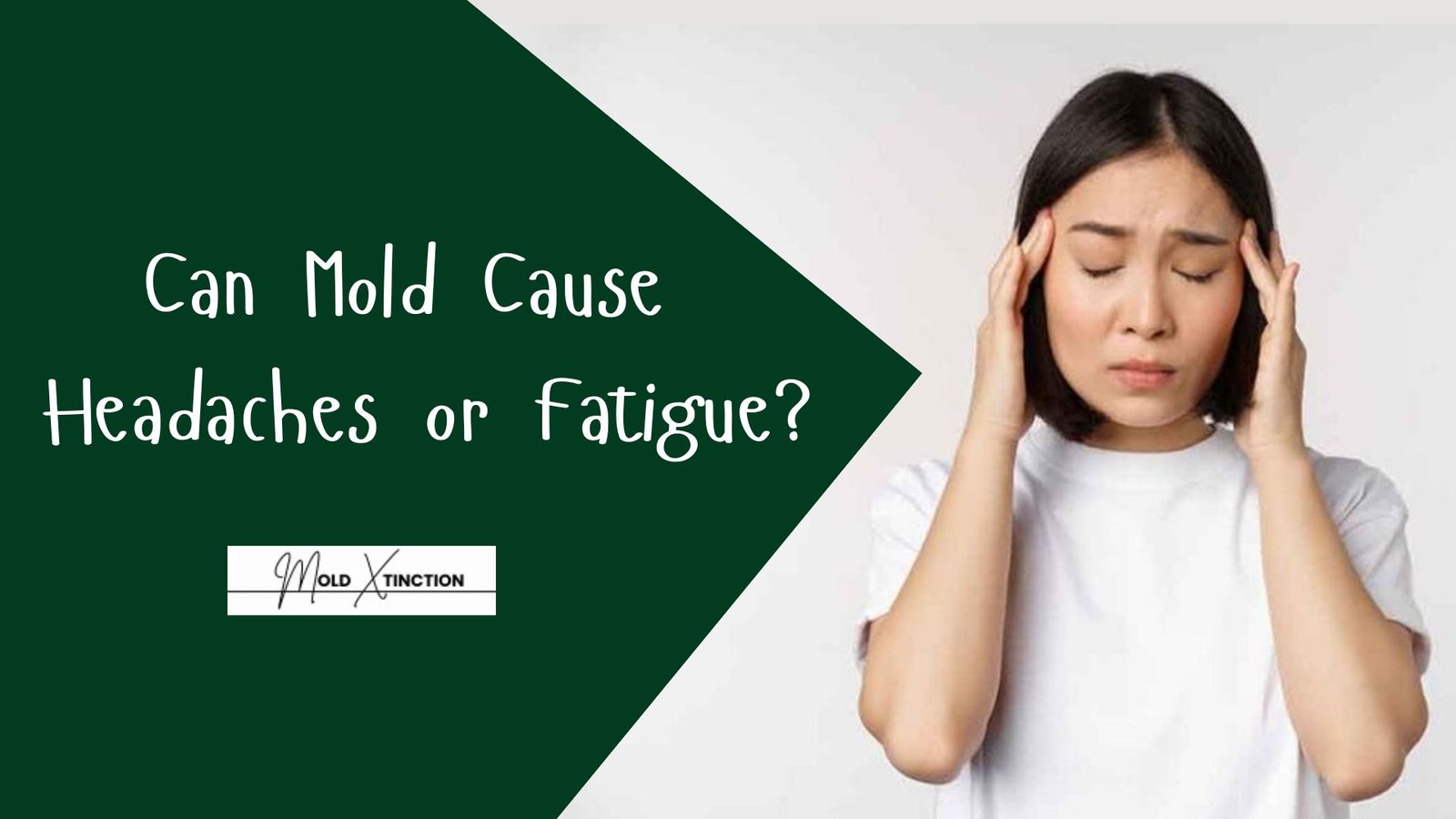Can Mold Cause Headaches or Fatigue? Yes, it can. But it doesn’t stop here, there are so many things we want you to learn alongside how to prevent it for your safety in this article.
Many common health problems like headaches and constant fatigue could all be caused by undiagnosed mold exposure within walls and across the board in your living space.
Mold releases tiny spores in the air and it’s just the ingestion of these spores over a period of time that can cause health problems in people of all ages.
If you’ve been living with unexplained fatigue or almost constant headaches and doctors can’t figure out why, it may be because of mold and they don’t know it.
This article explains in simple language how mold works — how it can cause headaches and low energy in the body.
We’ll also talk about the signs to look for and even why it’s best to hire a professional mold remediation service which is the safest and best option.
What's In This Article
ToggleHow Can Mold Affect Your Health?
When mold grows in your home it doesn’t just look ugly and smell bad; it also silently and insidiously affects your health and well being. Mold is not just a surface problem. It transmits through microscopic spores that are suspended in the air and can enter your body when you’re not even aware of it.
These spores can move through the air and end up in other areas of your home, especially the areas with stagnant air or areas with excessive moisture. You may not actually see any mold but it can be there and growing.
And then after a period of time, constant exposure can cause you health problems and make your home an uncomfortable and unsafe place to stay.
Sensitive individuals can develop such symptoms:
- Sneezing
- Runny or blocked nose
- Itchy eyes
- Skin rashes
- Sore throat
- Wheezing
- Asthma attacks
- Dizziness
Some people also experience headaches, extreme tiredness after being around the mold. This can be the case even if the mold is hidden and not visible.
Let’s take a look at that.
Can Mold Cause Headaches or Fatigue?

Yes. Mold can cause headaches. And not just one kind of it but it can also cause pressure headaches, sinuses headaches and even migraines.
Inhaling of mold spores can cause your body to release certain chemicals like histamine. This can cause inflammation and tension to your sinuses thus, making your head weary.
You might think that
- A dull pain behind your eyes
- Tightness in your forehead* A pulsating or throbbing feeling in your head
- Nausea if the headache gets intense
Have you noticed that your headaches get worse when you’re at home and especially in some rooms like bathroom, basement and kitchen? If so, you have mold.
The longer you’re exposed, the more it can get worse.
Can Mold Make You Tired?
Yes. Mold can make you tired, that is, you are always tired even when you had a whole night of sleep or were able to take a good rest during the day. It’s not a kind of tiredness that a nap can remove, it lingers and makes everything seem harder than they should be. You may not be able to wake up in the morning, you may lack motivation during the day or you may feel tired soon after a little bit of work.
This is the effect of mold on energy:
- It triggers inflammation- Your immune system works all the time looking after your health, using energy.
- It affects breathing- Low level of air quality can also reduce air available to your body.
- It disrupts sleeping- The presence of mold may bring with it coughs, sneezing or even itchiness in the skin and these are likely to keep you awake at night.
As time goes by this tiredness may affect your job, your mood and even your relationships.
Why Is Mold So Bad?
Not everyone is equally affected by mold. There are those who are more sensitive than others, particularly:
- Children
- Elderly people
- Asthmatic individuals
- Allergy sufferers
- Individuals with weak immune system
- Women with pregnancy
These groups of people would be more likely to develop health problems because of mold exposure.
Mold can even make healthy adults sick after long term exposure to the mold. That’s why one should not ignore the symptoms of mold even if they are minor at first.
Signs That Mold Might Be In Your Home
Sometimes you may see mold on your very visible surfaces- walls, ceilings, bathroom tiles or windows sills. In other cases it can hide in areas that you hardly ever inspect- behind walls, under carpets, in air vents or under sinks. Although you may not see it, your body may respond to it anyway.
Here are some of the warning signs to watch out for:
- Musty, earthy smell
- Headaches that come and go depending on where you are
- You feel tired easily and worn out
- You find it difficult to feel pain in your chest
- Spotting of molds on walls, ceilings or windows
- A wallpaper bubble or flake or cracking paint
- Stains of water in ceilings or floors
- Coughing or sneezing all the time in the house
Do something fast about it.
What to Do If You Think Mold is Making You Sick
If you think your mold is giving you headaches or making you feel weak, you should inspect your home first.
Start by:
Check in misty places such as the bathroom or basement
Smell for musty or moldy smells
Look behind and under carpets
See if symptoms go away when you are out of the house
You can also talk to your doctor. Be sure to tell them your symptoms, experience, worries and your concern about mold. They may recommend allergy tests or other tests.
And above all…
Call a Professional Mold Remediation Service
Even if you see mold, don’t clean it up especially if you have a big area or you feel sick. More spores can be released into the air when you scrub mold.
Where this is done, the best thing to do is to call a mold remediation company.
They have the right equipment and safety gear to:
- Find areas where mold is not visible
- Properly clean the affected areas
- Prevent mold from coming back
- Improve air quality of your home
- Protect your loved ones
Trying to do it yourself may worsen the situation. Professionals will get it done on the first try.
Are Children at risk of mold?
Yes, children get affected by mold more than adults.
Their lungs and immune systems are not fully developed and children are more sensitive to air quality. A small amount of mold in a child’s room will result to:
- Trouble sleeping
- Wheezing or Coughing
- Tiredness
- Bad school performance
- Headaches
Your child may be sick at home often or have low energy; a good idea is to inspect the home and check for mold.
Mold Prevention
Mold can be prevented at an early stage. Here are some easy steps:
- Fix broken pipes, roof or sinks
- Ventilate your home
- Put a dehumidifier in humid rooms
- Deal with water spills immediately
- Don’t dry clothes indoors
- Bathrooms and kitchens should not be wet
- Dark corners, basements and storage should be checked regularly
Taking care of your home will save you and your family.
When to Call a Pro?
Call a professional mold remediation service when:
- You see mold growing on a wall or ceiling
- The air in your home is damp or stuffy
- You or your family members are sick without any reason
- Symptoms disappear when you leave the house
- You had a water damage recently
- You already cleaned the mold but it came back
Don’t wait until mold spreads.. It’s cheaper and easier to fix it at an early stage.
📞 Contact Us
Conclusion
Mold will give you headaches and fatigue. These issues will creep into your daily life and make it hard to enjoy the day, focus at work and spend time with your loved ones. If you have no obvious reason to be drained or your head is aching all the time at home, then it’s probably the mold. You and your health are important and being in a clean and safe environment is one of the keys to making every day the best. Don’t try to DIY a mold issue. Call a professional mold clean-up team They have the experience, equipment and know-how to remove mold safely and thoroughly. Come to us now.
Helpful Guide:


